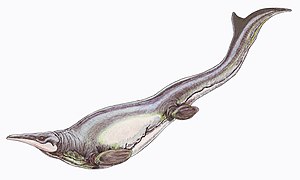Plotosaurus
| Plotosaurus | ||||||||||||
|---|---|---|---|---|---|---|---|---|---|---|---|---|

Plotosaurus bennisoni in a living reconstruction |
||||||||||||
| Temporal occurrence | ||||||||||||
| Upper Cretaceous ( Maastrichtian ) | ||||||||||||
| 72 to 66 million years | ||||||||||||
| Locations | ||||||||||||
|
||||||||||||
| Systematics | ||||||||||||
|
||||||||||||
| Scientific name | ||||||||||||
| Plotosaurus | ||||||||||||
| Camp , 1951 | ||||||||||||
Plotosaurus (= swimming lizard ; Syn .: Kolposaurus ) is a genus of mosasaurs from the late Upper Cretaceous . Originally two species were described P. bennisoni and P. tuckeri . The species were named after the discoverers of the fossils A. Benninson and WM Tucker. A new investigation of the type material of both species has meanwhile shown that only the species Plotosaurus bennisoni is valid and P. tuckeri is a junior synonym.
features
Plotosaurus was a large, 10 to 13 meters long and long-tailed mosasaur. Its body was short and high, the tail had 64 vertebrae and was raised by the extension of the spinous processes, which were flat at the end. The fingers and toes of the limbs were close together, forming a stiff wing-like fin. The fins were long and narrow, the number of finger bones on the single fingers increased (hyperphalangia).
The skull was slender and reached a length of 53 cm. The muzzle, which was filled with many small, sharp teeth, was pointed. The eyes and nostrils were large. Overall, with its modifications of skull, fins and tail , Plotosaurus approximated the ichthyosaurs, which were long extinct in its time, and was probably the fastest swimming mosasaur. Perhaps like this, it lived on smaller prey, which it also hunted in deeper water. The fossilized epigastric region shows signs of the remains of fish. Of all mosasaurs, Plotosaurus shows the highest degree of adaptation to the oceanic habitat.
A newly found Plotosaurus skeleton, in which parts of the skin are also preserved three-dimensionally, provides an insight into the skin structure of an advanced mosasaur for the first time. The skin is covered with cold scales, possibly reinforced with osteoderms . The scale cover probably led to a reduction in surface drag when swimming quickly, similar to what the anvil-shaped placoid scales of the sharks do .
Individual evidence
- ↑ a b c Johan Lindgren, Michael W. Caldwell, John WM Jagt: New Data on the Postcranial Anatomy of the California Mosasaur Plotosaurus bennisoni (Camp, 1942) (Upper Cretaceous: Maastrichtian), and the Taxonomic Status of P. tuckeri (Camp , 1942). In: Journal of Vertebrate Paleontology. Vol. 28, No. 4, 2008, ISSN 0272-4634 , pp. 1043-1054, doi : 10.1671 / 0272-4634-28.4.1043 .
- ↑ Michael J. Everhart: Rapid evolution, diversification and distribution of mosasaurs (Reptilia; Squamata) prior to the KT Boundary. In: Tate 2005. 11th Annual Symposium in Paleontology and Geology. The Cretaceous-Tertiary boundary. Adaptive radiation after the bottleneck. Tate Geological Museum - Casper College, Casper WY 2005, pp. 16-27, online at oceansofkansas.com .
- ↑ Richard Ellis: Sea Dragons. Predators of the Prehistoric Oceans. University Press of Kansas, Lawrence KS 2003, ISBN 0-7006-1269-6 .
- ↑ Ben Creisler: Dinosauria Translation and Pronunciation Guide ( Memento of October 13, 2011 in the Internet Archive )
- ↑ Johan Lindgren, Carl Alwmark, Michael W. Caldwell, Anthony R. Fiorillo: Skin of the Cretaceous mosasaur plotosaurus: implications for aquatic adaptations in giant marine reptiles. In: Biology Letters. Vol. 5, No. 4, 2009, ISSN 1744-9561 , pp. 528-531, doi : 10.1098 / rsbl.2009.0097 .